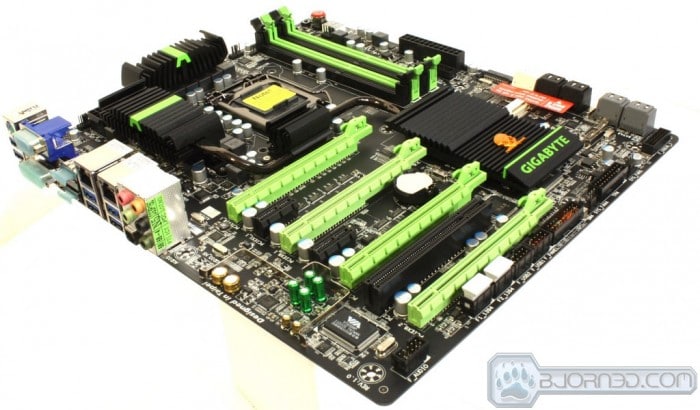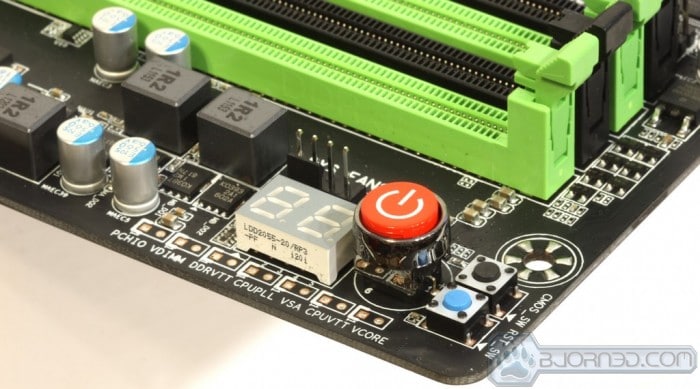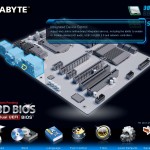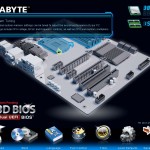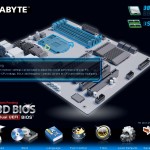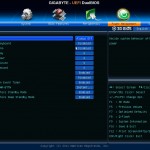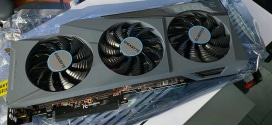GIGABYTE now has a second entry into the G1.Killer series for the Z77 lineup. Needless to say, when we look at a gaming board, we expect the appearance to scare the competition away, and the power to back it up. Does the G1.Sniper 3 deliver? Let’s take a look.
Introduction – GIGABYTE Sniper M3
 GIGABYTE released the G1.Sniper M3 earlier this year. We were not overly impressed with the board as there were some obvious areas that we thought could be improved to be an awesome mATX board for the budget gamer. Now we have the G1.Sniper 3, and we are truly impressed—the difference between the Sniper 3 and Sniper M3 is as big as night and day. The G1.Killer series started last year with the inclusion of the Bigfoot Networks Killer network processor to improve gaming performance. Many thought it was gimmicky, and for the most part it is, but it has over time become somewhat of an industry standard on gaming boards. The G1.Sniper 3 is an EATX form factor, unlike the mATX form-factored Sniper M3. The size increase is well warranted, however, once you look at all the components and featured on this board.
GIGABYTE released the G1.Sniper M3 earlier this year. We were not overly impressed with the board as there were some obvious areas that we thought could be improved to be an awesome mATX board for the budget gamer. Now we have the G1.Sniper 3, and we are truly impressed—the difference between the Sniper 3 and Sniper M3 is as big as night and day. The G1.Killer series started last year with the inclusion of the Bigfoot Networks Killer network processor to improve gaming performance. Many thought it was gimmicky, and for the most part it is, but it has over time become somewhat of an industry standard on gaming boards. The G1.Sniper 3 is an EATX form factor, unlike the mATX form-factored Sniper M3. The size increase is well warranted, however, once you look at all the components and featured on this board.
The board comes in at a price of $279.99 on Newegg, which puts it in the same price bracket as the ASUS P8Z77-V Deluxe. For a top-end gaming board, with this level of features, we can say that is a very nice price indeed.
Features & Specifications
New Digital power design
GIGABYTE has long been a proponent of the analog power design. However, we have seen a noticeable shift towards digital power control, and with the G1.Sniper 3 they have shown their hand with a strong digital solution covering CPU, iGPU, Memory and VTT all falling in line behind a digital controller. This should speak well for the board’s capabilities, as digital solutions have proven to be excellent for precise power management and control, opening the doors for better power efficiency and tweakability when overclocking.
GIGABYTE 3D BIOS
GIGABYTE has implemented the 3D BIOS on the X79, and this is their form of a clickable UEFI GUI BIOS interface. The board image has been significantly improved and the interface smoothed out a little, but we will discuss that in more detail when it comes to the BIOS section of this review.
Super Sight
GIGABYTE offers a feature called “Super Sight”, which similarly to the Sniper M3, signifies the Sniper 3’s multi GPU capability. The M3 covered dual card SLI or CrossFire solutions but with the G1.Sniper 3 GIGABYTE went all out with a PCI-E Gen 3 PLX controller to enable a full 4 slot population at x8 Gen 3 spec for full 4 way SLI and CrossFire action. This is huge as PCI-E Gen 3 spec is double the theoretical data rate of the Gen 2 spec and therefore with 4 cards at x8 Gen 3 you will see similar bandwidth to 4 way x16 on Gen 2 platforms all on this Z77 board. This should allow for some really crazy GPU configurations or even more if add in cards are needed for processing or connectivity this could serve well also but we really see with this being a gaming class board that this feature woulds most likely rest primarily with GPU expansion.
Virtu MVP
GIGABYTE has included Virtu MVP on their motherboard just like we have seen on other Z77 boards we have taken a look at recently. Virtu MVP allows the user to pair the iGPU and discrete cards for some really cool features, such as HyperFormance. HyperFormance pre-renders frames by the iGPU and removes some of the workload from the discreet GPU. This helps by delivering even higher framerates in games and other 3D applications.
GIGABYTE ON/Off charge
GIGABYTE does have a pretty neat feature: its ON/OFF charge. ON/OFF charge allows charging of even high load devices in all power modes, even (S5) power-off mode. This may not seem like such a big deal until you need to charge your phone and realize your system is off. Without this feature, you would have to power on your system and leave it on just to charge the device. With the ON/OFF feature, it’s not necessary to do that, and you can just have it plugged in without needing to worry about keeping your system powered on.
Ultra Durable 4
GIGABYTE has been promoting their Ultra Durable designs for some time now, and now with the Ultra Durable 4, GIGABYTE has added even more features into an already impressive package. Originally, we can remember when 2oz copper PCB was one of the biggest selling points, and now it has added many more features such as the new Glass Fabric PCB, Thermal protection, Humidity protection, Electrostatic protection and Power Fault protection. These all add up to a complete package of protections and features that should make for a solid and long lasting motherboard.
ESD Protection
GIGABYTE has also built in ESD protection. ESD is ElectroStatic Discharge, which in a nutshell means all the little static spikes that can develop from you or even just the environment. These discharges are dangerous to components, as when you are dealing with micro voltages, many issues can develop from even the smallest blip. Humans always consider static to be harmless as it is just a small sting or tingle, but we fail to remember that those static discharges can be in the thousands of volts. Because of the low amperage, it won’t hurt a person, but it could still damage components. These ESD circuits are basically a buffer to protect the critical components and they take the brunt of the static shock to ensure the components live a nice happy life, or at least have a better chance of it.
For full specification listings see GIGABYTEs website here
Overview of the GIGABYTE G1.Sniper 3
The packaging is what one has come to expect from the G1.Killer series of boards with a military camo theme. It is overlaid with multiple features listed to show off what the board has to offer. This includes such features as the Integrated Killer NIC, Creative audio controller and etc. The rear is similar fare as it covers a general overview of the board layout and features as well but in more detail.
- G1 Series Poster
- G1 Series Decal Set
- SATA Cables
- IO Shield
- Wi-Fi/BT4.0 card w/ dual antennae
- USB 3.0 front panel 3.5″ interface
- SLI Ribbon Cable
- 3-Way SLI Bridge
- 4-Way SLI Bridge
- Crossfire Ribbon
- User Manuals
- Installation Disc
There is a lot here to ensure no matter the configuration there would be no issues installing a system utilizing the G1.Sniper 3. The Wi-Fi PCI-E card is one of the more interesting included features as it offers pretty much complete wireless connectivity if using Bluetooth keyboards and mice. Also, being Wi-Fi ready means there is no need to position the system in close range to a network jack as it can connect to any wireless network.
Here we see the overview of the board and its layout. Like many enthusiasts boards we have seen, we always praise those who place connectors in good locations and this is no different as every connector is very well placed. We have covered connector placement many times but just to explain, it really makes a big difference as to how easy it is to route cables and hide them when the connectors are at the board’s edge. Also, with connectors at the board’s edge, wire visibility is minimized, as the cables are at the edge of the board and not strewn over it.
Click Image For a Larger One
- PS2 combo keyboard/mouse port
- 6x USB 2.0 Ports
- D-SUB Output
- DVI-D port supporting 1920×1200 Resolution
- HDMi Connection supporting up to 1920×1200 Resolution
- Displayport output supporting up to 2560×1600 Resolution
- Intel Gigabit LAN port
- Killer Networks Gigabit LAN
- up to 5.1 Channel HD audio via creative Chipset w/ Optical S/PDIF output
The connectivity is complete but we do wish the Wi-Fi/T 4.0 module would have been integrated into the rear IO or even a breakout module like the ASUS solution, as 4-Way SLI/CrossFire users will find issues mounting the PCI-E x1 wireless card with all slots populated.
Click Image For a Larger One
The audio solution uses MUSE caps which are known for their usage in high end audio circuit. This is an excellent choice in conjunction with the Creative audio controller to ensure the best possible audio output for your gaming needs.
Click Image For a Larger One
The Storage needs are well covered as there are 10 SATA ports, 6 of which are fed by the PCH (4x SATA 3G and 2x SATA 6G) while the other 4 are SATA 6G capable and are fed from the additional Marvell 88SE9172 chipset via the Gray in color ports.
The included mSATA is fed a single 3G capable port and when used disables port 5 of the PCH ports. The mSATA is a cool feature as it can allow for a full storage drive up to 240GB onboard without any cabling necessary.
Click Image For a Larger One
We mentioned previously the implementation of a digital controller into the GIGABYTE board and this is definitely a good step for them as it allows for more precise power delivery, performance and reliability in the long run. It should also allow for some pretty nice overclocking and possibly at lower voltages as well. This is a welcome step in my book as the performance of digital solutions have been seen and shown to be awesome performers and I am happy to see that GIGABYTE is progressing to provide the best possible performance.
Click Image For a Larger One
Here we pulled the cooler from the CPU power circuits to get a look and showing the 8 Pin CPU ATX connector. It feeds the 12 phase digital VRM ready to feed your CPU every want and need.
BIOS Overview
3D BIOS
The advanced section is very similar to the older AMI BIOS that we have grown used to on the GIGABYTE boards of yesterday, but without the bright blue background which makes us smile. It’s like the old working BIOS you’re used to but with a much more eye-friendly color scheme.
This is all standard fare which we have grown used to with the GIGABYTE BIOS. The adjustability is very good and without a doubt the G1.Sniper 3 feels very capable just working with the settings. There are even some special settings tucked away that when an overclocker knows how to use can enhance specific benchmarks performance by fine tuning the board for extra efficiency in those benchmarks.
Here we see the basic system settings this is strictly informational and shows current system info along with an option to show the installed drive info.
Click Image To Enlarge
Here is the BIOS features area and it covers most all of how the board posts and what order parts post as.
Click Image To Enlarge
Here are the final peripheral and power settings to allow for setup of the rest of the minor settings along with power management and other common settings that we have seen on most boards. It is pretty standard fare but is laid out well and in a way that most users should have no issue locating the setting they are looking for.
Testing & Methodology
We’ve expanded our testing suite considerably since the X79 chipset release, and will continue to use the same methods for most of the motherboards and CPU’s we test. In the interests of thoroughness and accurate results, we run each test at least three times, and some tests more than that. We average the total of all the tests from each benchmark then report the average here.
The OS we use is Windows 7 Pro 64bit with all patches and updates applied. We also use the latest drivers available for the motherboard and any devices attached to the computer. We do not disable background tasks or tweak the OS or system in any way. We turn off drive indexing and daily defragging. We also turn off Prefetch and Superfetch. This is not an attempt to produce bigger benchmark numbers. Drive indexing and defragging can interfere with testing and produce confusing numbers. If a test were to be run while a drive was being indexed or defragged, and then the same test was later run when these processes were off, the two results would be contradictory and erroneous. As we cannot control when defragging and indexing occur precisely enough to guarantee that they won’t interfere with testing, we opt to disable the features entirely.
Prefetch tries to predict what users will load the next time they boot the machine by caching the relevant files and storing them for later use. We want to learn how the program runs without any of the files being cached, and we disable it so that each test run we do not have to clear pre-fetch to get accurate numbers. Lastly we disable Superfetch. Superfetch loads often-used programs into the memory. It is one of the reasons that Windows occupies so much memory. Vista fills the memory in an attempt to predict what users will load. Having one test run with files cached, and another test run with the files un-cached would result in inaccurate numbers. Again, since we can’t control its timings so precisely, it we turn it off. Because these four features can potentially interfere with benchmarking, and and are out of our control, we disable them. We do not disable anything else.
One thing to note is that we are revamping our testing method in order to better represent motherboard performance and offering to you guys the consumer. Also we want to make it an easier read for you without miles of endless charts. Please feel free to provide feedback on what you think as many benchmarks will be shuffled or removed completely.
Test Rig
| Test Rig | |
| Case | Thermaltake Level 10 GT |
| CPU | Intel Core i7-3770K |
| Motherboard | GIGABYTE G1.Sniper 3 |
| Ram | 16GB Patriot Viper Xtreme 2400MHz + |
| CPU Cooler | Swiftech H20-220 Edge |
| Hard Drive | Western Digital Velociraptor 300GB |
| SSD | Intel 510 series SATA III 120GB |
| Optical | ASUS BD-ROM |
| GPU | Asus GTX680 Top/GTX 580/Intel HD 4000 |
| Additional Cards | N/A |
| PSU | Thermaltake Toughpower Grand 1200W |
| Mouse | Thermaltake esports Black gaming mouse |
| Keyboard | Thermaltake Meka G1 mechanical gaming keyboard |
Test Suite
We will use the following applications to test the performance of the Motherboard. Benchmarks
| Benchmarks |
|---|
| PCMark 7 |
| 3DMark 11 |
| Cinebench R11.5 |
| Unigine Heaven 3.0 |
| SuperPi |
| Metro 2033 |
| SiSoft Sandra 2011b |
| X264HD |
Overclocking
Ever since the Sandy Bridge came around we have noticed a trend going on here. The boards make little difference when finding a 24/7 clock for gaming. The difference really happens when pushing on extreme benchmarks that the board will make a difference but for the most part under normal usage all of the boards perform very close to one another. This may seem a little confusing but to explain more clearly the newer architectures tend to be so easy to clock that the limit really does become the chip or cooling itself. Until you start delving into the extreme benchmarking and overclocking world all boards will do similar clocks at close to the same settings in most cases so clocking on this board was of little difference.
The G1.Sniper 3 definitely gets to our 4.6GHz benchmarking setting rather easily and to my surprise it was rather reasonable for the CPU voltage required and stability was rather good. We cannot say the same for the maximum clock as 4.8GHz – 5GHz was quite troublesome as the board just simply is not as easy to overclock as some others. This is not to say that the board cannot reach 5+GHz it will just require more tuning and tweaking to get there with a good measure of stability.
The board has all of the right settings in the right places it just definitely will require a bit more knowledge as auto settings do not necessarily take you as far as some other models we have used.
For testing continuity and to keep the clock at something that should be obtainable by most users we are sticking with 4.6GHz will give us some great performance along with a reasonable clock that will give us the best possible platform for the enthusiasts gamer.
Important note: Overclocking can cause component failure. Please exercise caution when attempting any level of overclock on system components.
Temperatures
The temperatures were recorded with RealTemp while running wPrime 1024 right before the end of the 5th run. The results were recorded carefully. After the results were recorded, we waited for 30 minutes before taking Idle temperature measurements. The results were as follows:
| CPU Temperatures | Temperature (Idle/Load) |
| G1.Sniper 3 OC (4.6GHz) | 35C/67C |
| G1.Sniper 3 | 28C/52C |
| Chipset Temperatures | Temperature (Idle/Load) |
| G1.Sniper 3 OC (4.6GHz) | 48C/55C |
| G1.Sniper 3 | 39C/48C |
We used the same Swiftech LCS to ensure similar temperature comparisons available as similar application and mounting conditions were used.
Power Consumption
The power consumption was tested while running Wprime 1024 for a few minutes at stock settings. The results were recorded carefully with a Kill-A-Watt power consumption measuring tool at the wall. After the results were recorded, we waited for yet another few minutes minutes before taking Idle power consumption measurements.
| Configuration | Power Consumption (Idle/Load) |
| G1.Sniper 3 (4.6GHz) | 214W/445W |
| G1.Sniper 3 | 158W/362W |
The power consumption is not with GPU usage. This is with CPU/system loading but nothing graphically intensive in order to provide the most accurate results by not ramping up the GPU, which will pull significantly more power.
One thing of note is that this board is the highest in base power draw we have used, so we assume that some components are live full time or something is really chewing away at power as it really was shocking to see such a jump in power for no apparent reason.
Synthetic Benchmarks
SiSoft Sandra 2011
“SiSoftware Sandra (the System Analyzer, Diagnostic and Reporting Assistant) is an information & diagnostic utility. It should provide most of the information (including undocumented) you need to know about your hardware, software and other devices whether hardware or software. It works along the lines of other Windows utilities, however it tries to go beyond them and show you more of what’s really going on. Giving the user the ability to draw comparisons at both a high and low-level. You can get information about the CPU, chipset, video adapter, ports, printers, sound card, memory, network, Windows internals, AGP, PCI, PCI-X, PCI-E (PCI Express), database, USB, USB2, 1394/Firewire, etc.”
SiSoft Sandra is one of those benchmarks that gives a good idea of how a platform can handle specific tasks. We like this benchmark as it does a decent job of showing small efficiency differences from board to board while not taking too long to run. We did find that the performance here was quite close to our first Ivy Bridge benches we have run and this just goes along with what we have seen as since Sandy Bridge was first introduced. Most boards perform within a percent or so of each other and therefore the separation from board to board is more based on features rather than performance. The Sniper 3 handles the tests with ease and well within the performance of other boards we have tested.
Superpi
SuperPi is a single threaded benchmark which measures efficiency and is heavily influenced by architectural changes as much as it is by clockspeeds.
Superpi is a great efficiency benchmark and one we always use just because its simple and it shows improvements when they exist. The G1.Sniper 3 performs pretty damn well and recent BIOS optimizations GIGABYTE has been doing tells us this will likely only get better especially with some of the special settings just for running certain benchmarks makes this not just a gamer board but a great bench marker as well.
X264HD
The X264 benchmark is all about encoding and how well your CPU can do it. We know the 6 core chips for LGA2011 and 1366 are going dominate this as it has 50% more cores. For a comparison between Sandy Bridge and Ivy Bridge, there is a nice little performance increase likely due to the efficiency of the new die shrink. The G1.Sniper 3 shows about what we expect which is little to no difference in the face of competitors as we said previous the performance is simply too close from board to board.
Real World Benchmarks
3DMARK 11
3DMark 11 is the newest in Futuremark’s suite of benchmarking utilities. Its a fully capable DirectX11 benchmark which also stresses and analyzes the system performance as a whole to simulate a heavy rendering environment, such as a high end game or other application the end user may run. This benchmark was run with Performance settings 5 times and all runs were averaged for the results below.
3DMark 11 we opted for the Physics score as this test is CPU based and relies on no graphics, so we just see the CPU’s ability to render the preset Physics test. The G1.Sniper 3 shows some decent increases when run from 2600K to 3770. This has more to do with architecture than motherboard but still there are small variances from board to board.
Here we see the performance scaling in the 3D side of the benchmark and with a ASUS GTX680 installed. Now the i7-2600K has a PCI-E GEN 2 controller where the 3770K offers full PCI-E GEN 3 compatibility. This shows a small improvement without the help of the Virtu MVP software. With MVP the score jumps to a level nothing short of amazing which we have seen fro every MVP supported board.
Unigine Heaven 3.0
Unigine Heaven is a benchmark program based on Unigine Corp’s latest engine, Unigine. The engine features DirectX 11, Hardware tessellation, DirectCompute, and Shader Model 5.0. All of these new technologies combined with the ability to run each card through the same exact test means this benchmark should be in our arsenal for a long time.
Here we see once again the GTX680 getting a slight increase from the switch to GEN 3 lanes, but once Virtu MVP was enabled we see some serious increase. MVP works damn well which is nice for anyone looking for a small jump when needed in games.
Metro 2033
Virtu MVP once again bangs out amazing increases over the discrete GPU alone, and it is very cool to know that someone was able to pull off this kind of union with the iGPU doing the pre-rendering.
PCmark 7
PCMark 7 is a worthy synthetic full system benchmark, and we have found it a good measure of total system performance. The G1.Sniper 3 again shows little difference from what I have seen from other boards nut it does not show a drop in performance so its about par for the course.
CONCLUSION
The G1.Killer series has changed quite a lot and honestly it has matured a little as well. The gun and bullet shaped heatsinks are gone in favor of some more usefully designed and efficient, yet still stylish, heatsinks. The gun shaped sinks were not necessarily bad but they felt like they were a child’s toy, and really isolated the products’ market reach as some just felt it was far to gimmicky and unappealing. We like this change, and overall it makes for a much more appealing board. The green/black color scheme is a welcome addition to board options with a market flooded with black and red as of recent. Black and red is not bad but seems like everyone is doing it these days, and it’s nice to see the offering of such an extreme color difference as it will likely appeal to many gamers and modders alike.
The features are very good, including the Creative included audio with MUSE caps to ensure excellent class audio; Killer NIC for those who want a gaming centric specialized NIC controller that can be tuned for usage types; Wi-Fi/BT4.0 card with dual antennae ensures connectivity regardless of positioning. The PLX controller and 4-Way SLI and CrossFire capability are also great. The mSATA port to allows easy main drive installation onboard or even using it as a Smart response caching volume there are many possibilities here.
The performance of the board is on par with most we have tested as the CPU simply is the limit now days and only very minor efficiency improvements can be seen from board to board when using the same components. This is not a bad thing but it simply means that these boards as said before are down to a feature race and overclocking all except the most extreme is very similar from board to board.
The 4-way SLI/CrossFire is a definite pro. The inclusion of a digital VRM is a huge plus for performance, and the integrated gaming grade Creative audio and Killer network solutions also add flash (and a little substance). The mSATA port also adds versatility, and the power/reset switches are conveniently placed. The board has an overall solid feel to it which makes us feel more confident recommending it.
On the negative side, the board power consumption out of the box was definitely higher than any board we have tested to date. It is possible the controllers are in a constant on state, causing drain on power. Overclocking with this board was not easy, though we are hesitant to say that is a con. This is mostly because we can easily remember when good overclocking was a carefully cultivated skill, whereas now buyers expect top-end overclocks handed to them on a silver platter. While some board manufacturers can overclock very high via presets (which is not a bad thing), we will not criticize the G1.Sniper 3 to the moon and back just because it takes work to overclock. We will say that GIGABYTE could refine the BIOS for better functionality—especially in the GUI—and also add more presets for higher clocks on such a top end board.
Anyone looking for a lot of GPU expandability for the mainstream chipset could definitely consider the G1.Sniper 3 especially for multi GPU gaming setups and an all around extreme build the board just has everything any enthusiast gamer could ask for. With a little polish to the GUI, this board can be a contender for commanding this market segment.
| OUR VERDICT: GIGABYTE G1.Sniper 3 | ||||||||||||||||||
|
||||||||||||||||||
| Summary: The GIGABYTE G1.Sniper 3 is exactly what we expect from a G1.Killer series board. It has awesome performance and seemingly endless features. It earns the Bjorn3D Golden Bear Award. |
 Bjorn3D.com Bjorn3d.com – Satisfying Your Daily Tech Cravings Since 1996
Bjorn3D.com Bjorn3d.com – Satisfying Your Daily Tech Cravings Since 1996

